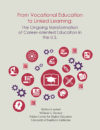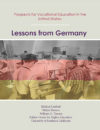Research Team | Background | Linked Learning Project | Research & Data | Findings| Publications | Funding
Competency-Based Education was a project to better understand the multifaceted relationships which are forged among individuals in Linked Learning educational programs. A qualitative, extended case study was conducted in a Los Angeles metropolitan area school district with the goal that interested parties might determine the sustainability of the Linked Learning initiative and the likelihood that it can be brought to scale.
Research Team

William G. Tierney
Former Pullias Center Co-Director
Michael Lanford
Postdoctoral Research Associate
Tattiya Maruco
Project Consultant
Carlos Galan
Team Member
Background
Educational discourse in the United States increasingly accentuates the importance of coupling secondary and postsecondary coursework with job training. Traditionally, the purpose of education in the United States has been conceived broadly, encompassing several goals, such as equity, civic participation, “whole-person” development, aesthetic appreciation, and greater cultural awareness. The renewed focus on equipping students with marketable skills is both a response to the globally-competitive labor market engendered by the financial crisis of 2008 and an implicit critique of the traditional American liberal education model.
With these trends in mind, researchers at the Pullias Center for Higher Education studied new educational paradigms that are attempting to redefine career-oriented education for the twenty-first century.
About the Linked Learning Project
Evolving from the philosophy that guided career-oriented academies (as advanced by the National Academy Foundation and in California, California Partnership Academies), Linked Learning is an educational initiative first piloted in California in 2009, which integrates academic instruction with technical curricula to foster real-world skills and facilitate work-based learning. The intent of Linked Learning is to prepare secondary school students for both college and career by providing high-quality academic instruction while facilitating relationships between students and adults through a variety of job-shadowing programs.
The relationships forged among coordinators and teachers that are at the heart of the Linked Learning distributed leadership model have not been studied. These sorts of relationships will need to be both scalable and sustainable if Linked Learning Pathways are to persist through institutional change and be viable in different educational and cultural contexts. Therefore, our research explored these multifaceted relationships by focusing on an urban California school district that is currently in the process of changing several of its long-standing California Partnership Academies into Linked Learning Pathways.
Research Questions, Design, and Data Collection
Our study was motivated by an overarching question: Is Linked Learning viable as a public policy to increase the career readiness of high school graduates in Southern California?
To answer this question, four ancillary questions were developed that had not been addressed by previous research:
- What are the relationships between students, teachers, administrators, and employers like in a Linked Learning program?
- How do industry partnerships happen in Linked Learning programs?
- Do teachers feel like they have a meaningful voice in decisions about school policies and practices?
- Are these relationships sustainable and scalable? Or are they so cumbersome and complex that they are not able to increase the capacity of the workforce in Southern California?
To determine whether Linked Learning is viable in terms of its sustainability and its ability to be brought to scale in California, a qualitative, extended case study of 91 administrators, pathway coordinators, teachers, and students involved in California career-oriented academies was conducted in a school district within the Los Angeles metropolitan area.
Data collection took place over a twelve-month period, beginning in November 2014 and ending in October 2015. Semi-structured interviews were conducted with 52 administrators, pathway coordinators, and teachers, obtaining access to participants primarily through snowball sampling (Creswell, 2009).
Findings
Our study had four key findings:
- Industry contacts are difficult to forge and maintain without teachers and coordinators who have significant professional experience, knowledge of the local context, and can navigate between the different organizational cultures of industry and education.
- The “family atmosphere” of a Linked Learning Pathway allows for trust, raised expectations, and a sense of ownership. Through these bonds, teachers can provide personalized support that enables students to build confidence, develop their academic skills, and – in some cases – clarify their personal interests. Nevertheless, teachers who develop a deep knowledge of their students’ needs and interests may find themselves conflicted about the dual goals of career training and college preparation.
- Teachers may be enticed to join a pathway due to the potential for autonomy and the empowerment gained by taking on a leadership role. Once they have assumed a leadership role, however, they may find that their vision for the pathway contradicts the accountability measures that are externally imposed by district- and state-level mandates. Additionally, teachers may find that work expectations increase dramatically as they are asked to cover a variety of leadership roles for which they have had little to no training.
- Without significant “buy-in” from teachers, administrators and students, Linked Learning is unlikely to make headway into districts that are already successful in sending students to college. Even when “buy-in” is likely among teachers and coordinators, incentives – whether they are financial or intrinsic – need to match the personal motivations and capabilities of the academic staff. Moreover, the interests of students and parents in the different types of careers offered by a potential Linked Learning pathway should be taken into account.
Publications
Publications

From Vocational Education to Linked Learning: The Ongoing Transformation
Michael Lanford, William G. Tierney (2015)
A brief history of vocational education in the United States, followed by descriptions of newer initiatives.
Categories: College Access, Linked Learning
linked learning vocational education
Download 649.77 KB 12196 Downloads

Prospects for Vocational Education in the United States
Michael Lanford, Tattiya Maruco, William G. Tierney (2015)
A report investigating possible obstacles to effective implementation of career-oriented education in the US by looking at the German vocational education system.
Categories: College Access, Linked Learning
linked learning vocational education
Download 633.74 KB 19336 Downloads
Lanford, M., & Maruco, Tattiya. (2018). When job training is not enough: The cultivation of social capital in career academies. American Educational Research Journal, 55(3), 617-648. https://doi.org/10.3102/0002831217746107
[link to news story]
Funding
This project was funded by a grant from the John Randolph Haynes and Dora Haynes Foundation.